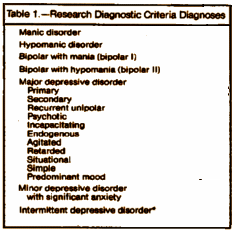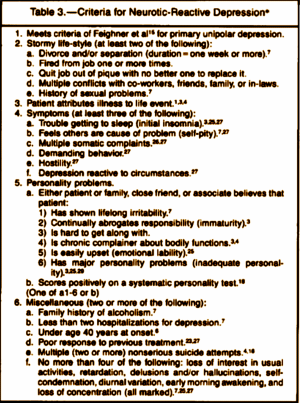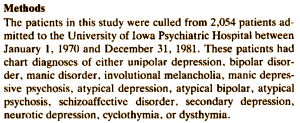

The term neurotic-reactive depression need not imply etiology. It easily can be defined on the basis of phenomenological factors. D’Elia et al defined it as "a reaction to external events or … an acute breakdown in persons with gross personality disorders of a neurotic nature [patients with unstable personalities and a tendency to react with depressive, anxious, or psychosomatic symptoms under the influence of stress in relatively ordinary life situations]." The authors pointed out that these patients’ characteristics would correspond to the diagnosis of reactive-neurotic depressive reaction in the World Health Organization manual. This definition is notable because it is irrelevant to the presumption of a dynamic etiology. In fact, it is similar to the definition used throughout most of the lifetime of the neurotic-reactive concept. Only recently has the concept assumed an etiologic meaning and mainly in the United States. The European literature dealt with the diagnosis on a phenomenological rather than a dynamic-interpretive basis. Because the term has had multiple meanings in recent years, agreement on diagnosis is difficult to achieve. If the criteria are limited to a significant depressive syndrome in a person who has a lifelong history of a stormy lifestyle and personality problems, the reliability should improve [in The Validity of Neurotic-Reactive Depression, 1985].
There is a further not-so-subtle point to be made about the patients considered in arriving at the depressive diagnosis that ended up in the DSM-III. They were in-patients, admitted to psychiatric hospitals because of depressive episodes that were show-stoppers. In Dr. Spitzer’s meta-analysis of diagnostic reliability in 1974, he reviewed studies primarily done on in-patients. Most studies of melancholic depression [including those people with depressions that occurred in the course of a Manic-Depressive Illness] were done on in-patients. Dr. Winokur’s studies of Neurotic Depressions were conducted by reviewing hospital charts – in-patients:

Certainly the choice of hospitalization was more available in those days, but still, these were very ill people – not the walking wounded. And if you read Dr. Winokur’s criteria above, he’s hardly describing prime psychotherapy or even biological treatment candidates. They are demanding, externalizing people who become severely depressed when their maladaptive ways of being in the world inevitably fail. Treatment is often more in the range of what medical doctors call palliative, and mental health clinicians might call crisis intervention. Successful and definitive treatment is not guaranteed, no matter the modality. This is the stuff of "nervous breakdowns" in a former time.
The majority of people with a diagnosis of Major Depressive Disorder in today’s world fit neither category. They are help-seeking out-patients whose dysphoria is real and interfering with their lives in significant ways, but their ill-ness is not in the show-stopper range. The older term Depressive Neurosis [stripped of the etiologic implications] did seem to refer to these patients. Dr. Spitzer’s early Research Diagnostic Criteria [first figure above] had a category for them – Minor Depressive Disorder. The term was doomed from the start because if they’re your symptoms, they’re not Minor. And if they’re Minor, your insurance carrier is not interested in paying for much in the way of treatment.
So there’s a further confusion of tongues that complicates the current psychiatric diagnostic system. Not only is the category Major Depressive Disorder a heterogeneous mixture of severe depressions, it’s widely used to describe a group of depressed people who were not included in the cohort used to define the diagnostic category itself. And while they were not used to validate the diagnosis, they make up the majority of the patients that are included in the numerous clinical trials of treatments, primarily medication treatments. They are neither patients who likely have a biologically colored propensity to melancholia nor those with severe personality disorder who periodically have show-stopping depressive episodes.
The reason you don’t see people like me who spent their days working with depressed, help-seeking out-patients signing on to committees in charge of diagnostic classifications is that we wouldn’t know where to start. Every case is different. A surprising number are people with soft disabilities: learning problems, attentional problems, visual difficulties not diagnosed early – people who have succeeded against a gradient that left its mark. Equally surprising are the number with unseen and unacknowledged traumatic experience lurking in the background discoloring living. Then there are idiosyncratic characterologic ways of being that were adaptive in an earlier dysfunctional environment, but lead to repeated misery in the adult arena. Some have distorted templates for interpersonal experience that make authentic relatedness a near impossibility. One could fill this page, this blog, maybe this Internet with the ways endowment, experience, and human-ness can tie knots in the complex systems required to live comfortably in the world. We will never have a diagnostic system to cover all of those bases nor a healthcare policy that can provide relief from all of those knots. What we could expect, however, is a precise diagnostic system that does not include people in inappropriate categories [like Major Depressive Disorder] that make them an unwitting and inappropriate market for expensive medications that won’t help [and may potentially harm]. It’s a predatory diagnostic category as it stands.
Dr. Allen Frances is completely correct in saying that the diagnostic system in mental health is rife with opportunities for untoward influence and unintended consequences. In the absence of the longed for biological markers, things are hard enough already, but the addition of industry influence, third party payers, ideological differences among specialties, and the scope of the task at hand, even the best of efforts is bound to need constant vigilance and a willingness to revise and retool frequently. From my perspective, the category Major Depressive Disorder has been the one most in need of a thorough overhaul from its birth. It appears that it has survived now three revisions untouched, perhaps because no-one can think of a better way to deal with depression. But frankly, I can think of little worse than what we have now. One very real possibility is that the recent DSM-5 Field Trials were actually accurate [kappa = 0.32 in adults and 0.29 in children]. It is not only an overly inclusive and an invalid category as we’ve suspected, but it can’t even be reliably diagnosed. It is certainly not a category for any kind of reliable research [and never has been].
Low periods of emotional and mental exhaustion after a period of intense PTSD symptoms—- night terrors, flashbacks, hypervigilance, sleeping difficulties, mental and emotional anguish— can easily be diagnosed as “depression” and treated with medication that will not help. After such an ordeal, people often need to TALK about it with someone who understands it and needs rest and perhaps a lighter workload or time off.
Also, medical causes of depressive symptoms should, in my opinion, be ruled out BEFORE a diagnosis of depression is made and drugs are prescribed. Pernicious anemia causes an atypical depression that includes sleeping up to fourteen or sixteen hours a day and never feeling like you’ve gotten enough sleep, not having enough energy to even form motivation or resolve, cognitive retardation to the point of not remembering common words— like staring at a table and trying to find the word “table” but being unable to. Aside from neglecting to treat the medical condition that is “a show stopper”, as you say, I can’t see how a body/brain starving for vital nutrients can be anything but needlessly taxed by psychoactive drugs. The anemia, of course, might also be a symptom of another and yet more serious illness.
Whatever would be wrong with simple not to speak of hopeful terminology, bereft of word-salad, not requiring commitment to something so easy for Pharma to kidnap and call its own. Thus: Transient Affective Disorder (or Transient whatever). Let’s say we saddle it with a built-in essential schema of rating scales for prior this and that (like morbidity, therapeutic facility, successes, failures, supports – maybe 4-6 of them), but require that the system build these all into a “final (not to speak of transient) determination” (the “what do I have doctor?” version). Don’t split all these aspects off into axis this and that, keep them as unified as they are and looking that way. Then let these pearls of diagnostic wisdom come clothed in language suggesting a range of outcomes: a successful journey through a crisis; a successful accessing of skills/other means for reorganizing life to deal with a dependably lifelong burden (whatever name it gets); or a repeatedly at best limitedly successful sometimes f_cking scary roller coaster through hell and back; etc. So TAD 1X, 1A, 1B, 2, 2A, 2B etc. Make these categories above all slightly less juicy considering Pharma’s hunger for marketing copy and permanent conditions: we can’t (mostly) all have gone permanently crazy over a single generation or two…
🙂
Hi again Mickey,
You’ll recall, I introduced myself to you, in my June 7 comment, replying to your “only one question…†(posted Friday, June 1). Again, to initiate my comment, I emphasize, that: I occasionally read your blog and generally appreciate what you have to say. (I.e., though questioning some of your conclusions, I do respect your views and do come in peace.) As with my last comment, I point out, I’m in agreement with much of the sentiment you’re expressing.
Ultimately, here, you are explaining that, “Major Depressive Disorder†is an extremely problematic ‘diagnostic’ category (yes it is, to say the least). You begin, “I think what I’m talking about here is the biggest of deals. The topic is about a debate in psychiatry that happened well over a quarter of a century ago, one that really has never been resolved – it just faded away before its time. It has to do with the nature of depressive illness.â€
So, you, “claim the divine right of a non-expert and simplify things down to two terms – melancholic and neuroticâ€; but, I wonder: is it not frequently difficult (if not impossible) to draw a clear line between the two? (Are the two not two poles on a spectrum?) And, is it really entirely fitting to call this issue, at last, “the mote in the eye of the DSM…†??? (Those are your final words in this post.)
I’d say it is a minor mote, as compared to the Major Mote, which develops from attempting to “diagnose†presumed ‘psychiatric conditions’ of those who, if they could ‘only’ being granted complete say in how they were to be ‘treated,’ would reject that ‘treatment’ which has been forced upon them.
Notably, you repeatedly emphasize this word, “in-patients” (putting it in italics and bold print), as you point out, “In Dr. Spitzer’s meta-analysis of diagnostic reliability in 1974, he reviewed studies primarily done on in-patients. Most studies of melancholic depression [including those people with depressions that occurred in the course of a Manic-Depressive Illness] were done on in-patients. Dr. Winokur’s studies of Neurotic Depressions were conducted by reviewing hospital charts – in-patients:â€
You then refer to a study snippet, from the last researcher you mentioned, Dr. Winokur, which reads (under the headline, “Methodsâ€): “The patients in this study were culled from 2,054 patients admitted to the University of Iowa Psychiatric Hospital between January 1, 1970 and December 31, 1981. These patients had chart diagnoses of either unipolar depression, bipolar disorder, manic disorder, involutional melancholia, manic depressive psychosis, atypical depression, atypical bipolar, atypical psychosis, schizoaffective disorder, secondary depression, neurotic depression, cyclothymia, or dysthymia.â€
You offer your analysis, “Certainly the choice of hospitalization was more available in those days, but still, these were very ill people – not the walking wounded. And if you read Dr. Winokur’s criteria above, he’s hardly describing prime psychotherapy or even biological treatment candidates. They are demanding, externalizing people who become severely depressed when their maladaptive ways of being in the world inevitably fail.”
First of all, I think it is interesting that you feel certain, “these were very ill people.â€
(To me, it is also interesting that you conclude, of such people, their, “Treatment is often more in the range of what medical doctors call palliative, and mental health clinicians might call crisis intervention. Successful and definitive treatment is not guaranteed, no matter the modality. This is the stuff of ‘nervous breakdowns’ in a former time.” Do you really mean to say that only “very ill people†experienced what were once called, ‘nervous breakdowns’ ???)
I believe it’s fair to speculate, that, “choice of [so-called] hospitalization” for many of those people was not their own; i.e., it was not their own choice – nor, then, was their “diagnosis” necessarily anything more or less than a label conveniently stuck upon them, to ‘justify’ their “involuntary medical treatmentâ€; and, indeed, such labeling would be virtually designed to describe any number of iatrogenic effects as supposedly part and parcel of an underlying “diseaseâ€; I would guess, that, on some level, you must understand that??
Of course, you are well aware of the the findings of these three famous researchers, in the field of psychology: Stanley Milgram and Philip Zimbardo and David Rosenhan.
Taking their most well-known studies and placing them side by side, a pattern emerges, which tells me, that, inevitably, many (and, perhaps, most) people who are placed in psychiatric so-called “hospitals” are not probably not ill to begin; though, yes, some may have entered the so-called “hospital†whilst in the midst of experiencing effects, of what were once called, “nervous breakdowns.”
And, were not “nervous breakdowns†generally considered a passing phenomena?
In the long run, these days, virtually all such people (once “hospitalizedâ€) come to be “diagnosed” with any number of the above mentioned labels (included in Dr. Winokur’s study).
You call them, “demanding, externalizing people who become severely depressed when their maladaptive ways of being in the world inevitably fail.â€
That seems a highly prejudicial (even flippant and terribly damning) judgment, which simply fails to take into account the likely fact that many (if not most) of those people are not just “in-patients,†they are, in fact, victims of highly aversive, unwanted ‘care’ – which typically includes forced impositions of terribly debilitating psychopharmacological drugs (and, sometimes, ECT). Such “hospital care†can be extremely traumatic. Naturally, then, many such “in-patients†may, of course, be less than pleasant research subjects. (For their own good, I’d wish them all the ability to rattle their cages and be at least somewhat difficult “patients†for their captors; they should know what it is to rebel against a truly unjust fate.)
Finally, please, don’t think I hold it against you, that you are so judgmental. You are not alone, amongst well-meaning psychiatrists (and other “mental health†professionals), who are similarly quick to judge such people, according those god-awful “diagnostic†labels they received as “in-patientsâ€; but, you have a good nose for what is or is not real science; so, I’d expect, soon enough, you’ll see that this so-called “involuntary care†really is the BIG Mote in the eye of the DSM (and, in the eye of most psychiatrists and retired psychiatrists, generally).
Respectfully,
J.
Please, excuse me; in referring to the work of Milgram, Zimbardo and Rosenhan, above, I had meant to write, this:
Taking their most well-known studies and placing them side by side, a pattern emerges, which tells me, that, inevitably, many (and, perhaps, most) people who are placed in psychiatric so-called “hospitals†are probably not ill to begin; though, yes, some may have entered the so-called “hospital†whilst in the midst of experiencing effects, of what were once called, “nervous breakdowns.â€
J.
Jonah
I take your point, however in “You call them, ‘demanding, externalizing people who become severely depressed when their maladaptive ways of being in the world inevitably fail.’†I’m paraphrasing Winokur’s criteria, not calling them anything myself. I thought it was a harsh indictment too.
Mickey,
Thank you for your clarifying reply.
You explain, “I’m paraphrasing Winokur’s criteria, not calling them anything myself. I thought it was a harsh indictment tooâ€; so, now I understand: it’s Winokur who was being awfully judgmental – not you, Mickey. (Truly good to know.)
Of course, the friendly argument I’m forwarding culminates in my ultimate point, regarding the BIG Mote (as I see it). That remains unchanged by your clarification; and, hopefully, it’s not overly presumptuous of me, that I imagine you may find some merit in this view, of mine? After all, you do say, “I take your point.†🙂